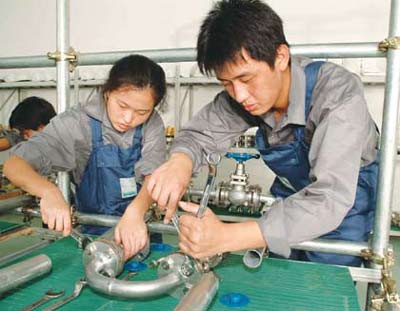| Home / Education / Photos | Tools: Save | Print | E-mail | Most Read |
| Vocational Education – A New Chance for Students? |
| Adjust font size: |
In an effort to improve vocational education the Ministry of Education recently announced that it would spend 2 billion yuan (US$255.7 million) to update teaching facilities and establish a quality curriculum at vocational colleges nationwide.
The effort is part of the country's pledge to invest 14 billion yuan (US$1.79 billion) in the vocational education system in the 11th Five-Year Plan (2006-10). This year, 3 billion yuan (US$383.6 million) was spent on pilot junior vocational education schools and vocational education centers down to county level bringing much-needed relief to teachers and students who have been crippled by long-standing financial shortages. As a result of poor resources, many vocational schools and colleges are burdened by a lack of suitable teachers, outdated facilities, irrelevant curricula and few internship opportunities. Some schools were even forced to raise their tuition fees, so strained were they by budget constraints, causing more impoverished students, the very students needing these chances the most, to be kept out. Currently, about 7 million students are studying in 1,300 vocational colleges with 20 million studying in 14,500 junior vocational schools. Under this structure, graduates from junior middle schools may choose to attend junior vocational schools or senior middle schools. After graduation from senior middle school, students wishing to pursue further education also have two choices: university or vocational colleges. Considerations taken into account when making this decision include the family's financial ability and students' academic performances. Normally poorer families send their children, who aren't particularly good in studies, to vocational schools. Junior vocational schools and vocational colleges often offer the same courses but the depth of learning varies. Naturally, those graduating from vocational colleges gain better career prospects. According to Sun Cheng, associate researcher with the China National Institute of Educational Research, the underlying reason for the skill shortage is an imbalance in the educational system that invests less in vocational education. The Vocational Education Law requires that 20 percent of the annual education budget goes to vocational education but in reality, this ratio is rarely observed. Statistics jointly released by the ministries of education and finance along with National Bureau of Statistics show the ratio of investment in vocational education has declined from 13.4 percent of the entire budget in 1994 to 7.1 percent in 2004. Worryingly, this ratio may further plummet across different provinces and municipalities. For instance in south China's Guangdong Province, which has a huge demand for skilled workers, junior vocational schools receive only 3 percent of the total education budget whereas secondary schools receive 32 percent, according to China Economic Report. "Ideally the per-capita investment for vocational education students should be three times that for secondary school but the practice in According to a 2001 national human resources report manufacturing workers in There may be a plethora of reasons behind these differences but one is shockingly clear. Front-line workers in these countries are often better trained than their Chinese counterparts and their products are considered to be of higher quality. "The lack of skilled workers has affected the quality of the products made in our country," said Liu Zhanshang, director of the Ministry of Education's vocational education department. Current investment in the vocational education system aims to meet In economic hubs such as the According to Yu Zuguang, deputy dean of the Ministry of Education's Vocational Education Research Center, The current rate of Chinese senior middle school graduates in tertiary vocational schools stands at 38 percent as opposed to 50 percent in Asian neighbors, The imbalance has also led to a different market response to vocational students and ordinary academic students. Ministry of Education statistics show that an average of 95 percent of vocational college graduates found rapid employment in recent years while for university graduates this fell to 73 percent. Despite According to Cheng Fangping, an expert in vocational education at the China National Institute for Educational Research, it would be better for pilot vocational colleges to break the norm. "Education authorities should consider the local situations in satisfying the regional and national economic development requirement," Cheng said. He also pointed out that vocational education currently overemphasizes textbook knowledge. "A new type of teaching methodology should be established in vocational schools, one that asks skilled technical workers to conduct the instruction instead of teachers with little actual experience," Cheng said. "Also the new teaching methodology will move students from classrooms to factories or internship locations." According to Cheng, instead of being viewed as only a part of the educational system, vocational education should actively foster collaboration with the business sector as well. " "Unlike in some countries such as South Korea, which provide more financial support to vocational than academic education China's vocational schools enjoy far less investment than that which goes to secondary education or universities. Therefore, they're not good enough to attract students and good students are not willing to attend these schools," said Wang Linfeng, a professor at the However, progress does seem to be on the cards across In July 2006, the Hebei Provincial Department of Education, Hebei Province International Education Exchange Association and New Times International Ltd, organized a training conference for vocational school teachers in Pingshan near
"We also placed emphasis on allowing the students to use the language for themselves. This would give them several options inside and outside the classroom," added Peeters. Peeters' words are prophetic as options are what vocational schools are increasingly offering their students. Recent surveys have shown that vocational school graduates usually secure employment far quicker than their university peers. (Chris Dalby from |
| Tools: Save | Print | E-mail | Most Read |
 |
| Related Stories |
